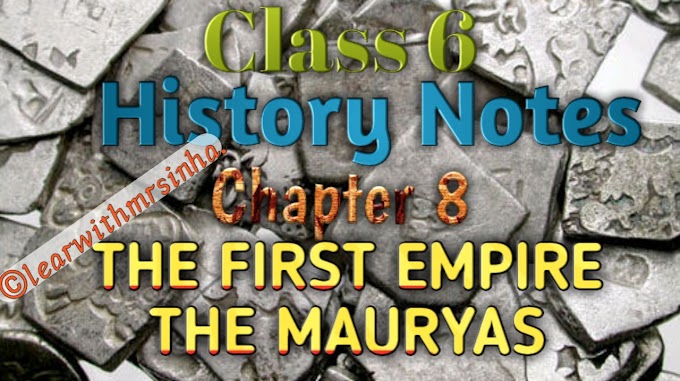Post Mauryan Period, the post mauryan period class 6 sst chapter 10 questions answer notes solution, the post mauryan period class 6 history chapter 10 notes, class 6 Our Past - 1 notes, chapter 10 Traders Kings and Pilgrims. Notes class 6 Ratna Sagar history notes class 6 pdf
The Post Mauryan Period
Tamilakam or Tamil (South India ) lies south of the Krishna River. Ruled by the Cholas, Cheras and the Pandyas. The period of the history of 'Tamilakam' is thus known as the Sangam Age main sources of information about this dinasty - sangam literature.
The Sangam texts :- (Earliest work of Tamil Literature)
Sangam mean Assembly. About 2,200 year ago, there was a geathering of Tamil poets and scholars under the patronage of the Pandyan kings. There assemblies were held. The work composed during two assemblies are lost. Third assembly was held between AD100 and 250 at Madurai. Over 2,000 poems were composed in Tamil during this assembly. Later these poems were compiled into many books which is known as Sangam Literature. It tells about the society and culture of that period.
The Three Periods of Tamilakam
The Cholas
- Ruled in the kaveri delta. Uraiyur - capital.
- Karikala - Most powerful king.
- Fought against cheras, Pandyas attacked srilanka and occupied a part of it.
- Constructed many roads (trade).
- Puchar or kaveripattanam - Portcity.
The Cheras (Keralaputras)
- Ruled over present day kerala and some part of Tamil Nadu. Vanj - Capital.
- Nedun Cheraladoan most famous chera king. Fought against both.
- Captured a Roman fleet.
- Trade with Rome and Egypt.
History Notes Class 6
The Pandyas
- Controlled the region around Madurai.
- Acording to Megasthanese ruler was a woman with a large army.
- Nedunchezhyan - Popular Ruler.
- Defeated both the cholas and the Cheras. Patron of art and literature.
- Famous for pearls. Exported to rome.
Economy
Kingdom - Very rich. Abundant natural resources and a flourishing trade. Land - Revenue. Money - Large Army, good administration, to poets and scholars. Sangam rewarded artists with gold, precious stone, fine clothes, etc. Trade earned a lot of money for the kingdom of South India Peper ( Spices), Gold, Precious stones, pearls and fine muslin and silk cloth were exported. to Europe, west Asia, South - East Asia and China. Roman ships visited the port of Arikmedus to exchange goods.
In North (while beigining sangam litrature) may tribes, especially from Central Asia, had crossed the Hindukush and entered India. There were the Indo - Greeks or the Bactrian Greeks, the shakas or seythians, the pahlvas or Parthians and the kushanas.
The Kushanas
- They established a powerful empire in North India.
- Defeated the Indo-Greeks, the Pahlavas and the Shakas and established themselves in the region around Taxila (Takshashila) and Peshawar.
- Later they occupied Kashmir, Punjab and parts of present-day Rajashthan and Uttar Pradesh.
Kanishka
- The greatest of the Kushana rulers. (became king in AD78) (Deeply influenced by Buddhism)
- Established a vast empire which included parts of Central Asia. Capital- Purushapura. (now Peshawar)
- Important cities - Purushapura, Mathura
- Fourth Buddhist Council was held in Kashmir. (At this council, scholars met and discussed issues and take imprtant decisions realated to buddhism)
- Ashvaghosha, - wrote the Buddhacharita, lived at the court of King Kanishka.
The Satavahanas
- Also known as Andhras, ruled the Deccan for nearly 300 years. Capital - Pratishana (modern Paithan in Maharashtra)
- Powerful Rulers - Sri Satakarni, Vasishthiputra Pulumayi, Yajnasri Satakarni and Gautamiputra Sri Satakarni, the most powerful of them all.
- Continuous military conflicts, especially against the Shakas, however, gradually weakened them. Eventually the empire broke up into many smaller kingdoms.
TRADE
Trade flourished during this period. The Indo-Greeks, Kushanas and the Satavahanas issued a ;arge number of gold, silver and copper coins. Ports - Broach, Kalyan and Sopara.
The development of new crafts also promoted trade. Taxila, Ujjayini and Mathura became prosperous due to trade.
The Silk Route
- It was called so because silk was the main item traded.
- The Chinese were the first to make silk, Chinese traders carried silk to other parts of the world along this route.
- There were several branches of this route. The main branch started from China, ran across Central Asia and ended at the West Asian provindes of the Roman Empire. It was through this route that India exported pearls, textiles, ivory, silk and precious stones. In return, India obtained glass, copper, tin and gold.
- Rulers protected the traders from attacks by robbers and in return, the traders gave them a part of their profits.
Science Notes Class 6
Religion
- Buddhism and Hinduism were the most widely followed religions.
- Buddhism was divided into two sects :-
- - Hinayana (earlier and the simpler)
- - Mahayana (new, with many rituals and ceremonies)
- Menander (Indo-Greek ruler) and Kanishka were Buddhists. They do donates to Buddhist monks.
- Nagarjunakonda and Amaravati were famous centres of the Buddhist culture.
- Most of the Satavahana rulers were Hindus.
- They worshipped Vishnu,Shiva and goddesses such as Durga.
- Hinduism by this time, had undergone many changes.
- Rituals, ceremonies and sacrifices became less important.
- The emphasis now was on loving devotion to God or 'bhakti'.
- A pure heart was all that was needed to worship god.
- The teachings of the Bhagavad Gita also became popular in this period.
Spread of Buddhism
- Afganistan became an important centre of Buddhism.
- The colossal statues of the Buddha at Bamiyan point to te importance of Buddhism in this region.
- The region of Bactria and Gandhara also came under Buddhist influence.
- The first step in the spread of Buddhism to Central Asia was due to the missionary activities of Emperor Ashoka. He sent missionaries to many places in Central Asia to popularize Buddhism.
- During the region of king Kanishka also, many Indian missionaries went to Central Asia. Introduced Mahayana Buddhism (New Form). Buddha was considered a form of god on earth.
- From Central Asia and China Buddhism spread to Korea and Japan.
- The famous Buddhist monk, Kumarajiva, went to china to spread Buddhism.
- Famous Chinese pilgrims who came to India (using Silk Route) were Fa Hien, Hiuen Tsang and It-sing. They came to study Buddhism, collect Buddhist texts and to visit Buddhist monasteries.
- Emperor Ashoka sent his son Mahendra and daughter Sanghamitra to Sri Lanka (South-east Asia) to spread Buddhism.
- Dipavamsa and Mahavamsa are the famous Buddhist writings from Sri Lanka.
- The Great stupa at Barobodur in Java was dedicated to the Buddha.
The strong Buddhist influence resulted in many changes in these foreign lands. Many peoples accepted Buddhism as their religion. They adopted Buddhist names, translated Buddhist scriptures into their native languages and built a large number of monasteries for monks to live in. Today, Buddhism is practised in Central and South-east Asia.
*****
- The Cholas, Cheras and the Pandyas ruled in South India. We know about them from the Sangam literature.
- The Sangam literature is in Tamil. It consists of many books.
- During the Post-Mauryan period , the Indo-Greeks, Shakas, Pahlavas and the Kushanas ruled in North India. The Satavahanas ruled in the Deccan.
- Kanishka was a king of the Kushana Dynasty. He patronized Buddhism.
- Trade flourished during this period. All the kingdoms traded with other regions. The Silk Route was very popular.
- Hinduism and Buddhism were the main religions. The doctrine of 'bhakti' was popular.
- Buddhism spread to other areas. This was largely due to missionaries, pilgrims and travellers. The Silk Route helped to promote it, especially in Central Asia and China.
Post Mauryan Period the post mauryan period class 6 sst chapter 10 questions answer notes solution the post mauryan period class 6 history chapter 10 notes class 6 Our Past - 1 notes chapter 10 Traders Kings and Pilgrims. Notes class 6 Ratna Sagar history notes class 6 pdf







0 Comments